Schneider Shorts of 1 March 2024 – the 3 Rs of Roche’s CMO, Portuguese zombie cures cancer again, with another Italian alpha male of medicine, retractions for Dana Farbericators, a Californian poet, a Nobelist, a Roman papermiller, and an Indian academician, and finally, with Radio Yerevan jokes in Elsevier!
Table of Discontent
Science Elites
- Offensive and humiliating – Giorgio Palù doesn’t suffer fools gladly
- A new professor – Simone Fulda avoids unemployment
- Remember why we work on cancer – Roche CMO Levi Garraway promotes Rigor, Reproducibility and Robustness
Retraction Watchdogging
- Scientific work of supraregional significance – Ken Anderson, a Singapore fraudster, and Austria’s superdoc retract old forgery
- You’ve gotten your pound of flesh already – Valerie Weaver’s poetry didn’t help11 and counting
- 11 and counting – Nobelist Gregg Semenza’s retractions still not really newsworthy
- Discussed with the highest scientific body – Chitra Mandal retracts paper, just when everyone gave up
- A very strong view – Filippo Berto loses paper, but not for papermilling
- Existence and nature of this company – Radio Yerevan jokes in Elsevier
Science Breakthroughs
- The door to new therapies – Sonia Melo once again cures cancer with exosomes
- The Path of Ideological and Political Education – provisionally accepted Chinese propaganda in Frontiers
Science Elites
Offensive and humiliating
On 22 February 2024, Italy was shaken by a high-profile resignation. As the national media reported, Giorgio Palù, emeritus professor of virology at the University of Padua, stepped down as director of Italian Medicines Agency (AIFA), ten days after his nomination for this job, on the grounds that the government’s Minister of Health Orazio Schillaci has “humiliated” him. Ansa quotes Palù (translated):
“”I inform you after a careful meditation – he writes in a letter addressed to the board of directors of AIFA – that the lack of harmony with the Minister and the absence of answers from the Government force me to resign as President appointed by Aifa hic et immediate”. Palù then called “offensive and humiliating” the assignment of a year. “I recriminate the total absence of listening from the Minister in the choices made for Aifa”, continues Palù.”
Now, Schillaci had his own scandal, because in his past capacity as medical dean and rector of the University of Rome Tor Vergata, he published fudged science. That was exposed by Elisabeth Bik, read Il Manifesto report from September 2023 and earlier Friday Shorts.
Aneurus Inconstans heard on the news of Palù’s achievement of his having published over 600 papers, and understood this as an invitation to look at them. The result is now on PubPeer, all with a close associate of Palu: Cristina Parolin, professor of medicine at the same University of Padua.

Totally fake gels, but don’t expect any consequences:
F Sarinella , A Calistri, P Sette , G Palù, C Parolin Oncolysis of pancreatic tumour cells by a γ34.5-deleted HSV-1 does not rely upon Ras-activation, but on the PI 3-kinase pathway Gene Therapy (2006) doi: 10.1038/sj.gt.3302770



Also this gel is outright fraud:
Nadia. Gabellini , V. Masola , S. Quartesan , B. Oselladore , C. Nobile , R. Michelucci , M. Curtarello , C. Parolin, G. Palù Increased expression of LGI1 gene triggers growth inhibition and apoptosis of neuroblastoma cells Journal of Cellular Physiology (2006) doi: 10.1002/jcp.20627

This is fraud also:
Arianna Calistri, Claudia Del Vecchio , Cristiano Salata , Michele Celestino , Marta Celegato , Heinrich Göttlinger , Giorgio Palù, Cristina Parolin Role of the feline immunodeficiency virus L‐domain in the presence or absence of Gag processing: Involvement of ubiquitin and Nedd4‐2s ligase in viral egress Journal of Cellular Physiology (2009) doi: 10.1002/jcp.21587

The above-mentioned Caduco et al 2013 paper was retracted for fraud right after it was published in 2013, proving that Palu is indeed qualified to lead Italian science:
Martina Caduco , Alessandra Comin , Marta Toffoletto , Denis Munegato , Elena Sartori , Michele Celestino , Cristiano Salata , Cristina Parolin , Giorgio Palù, Arianna Calistri Tsg101 interacts with herpes simplex virus 1 VP1/2 and is a substrate of VP1/2 ubiquitin-specific protease domain activity Journal of Virology (2013) doi: 10.1128/jvi.01969-12

This was the retraction notice from 1 June 2013:
“The authors regretfully retract this article at the request of the Journal of Virology. All the authors take responsibility for mistakes made in the final assembly of the figures, including unacceptable digital manipulation of data in panels of Fig. 1, 2, and 3, as follows:
- In Fig. 1B lower left panel, bands in lanes 1 and 2 were duplicated in lanes 3 and 4 and in Fig. 1B, lower right panel, the band in lane 2 was spliced into the image.
- In Fig. 2C, middle panel, the band in lane 4 was spliced into the gel image.
- In Fig. 2D, middle panel, the band in lane 4 was spliced into the gel image.
- In Fig. 3B, the “tubulin” blot in panel B was copied and pasted from the last three lanes of the “tubulin” blot of panel A and rotated 180 degrees.
- In Fig. 3C, in the area above the bands in the right panel of the left grouping, a gray rectangle was pasted over the image.
The editor in chief of the Journal of Virology has reviewed our raw data and has concluded that our original findings are supported, and, more importantly, that the major conclusion of the paper still stands, i.e., that VP1/2 interacts with Tsg101 and modulates the level of Tsg101 ubiquitination. Since the integrity of the data as presented was compromised, however, the authors retract this publication. We apologize to the editors and the readers of the journal for any inconvenience caused by our mistakes. We intend to resubmit the paper with corrected figures for reconsideration by the Journal of Virology.”
Just appoint Giorgio Zauli as the new AIFA head, and stop pretending.
La Piovra Ferrarese di Giorgio Zauli
Giorgio Zauli’s rectorship term ends. Will research fraud, media harassment and whistleblower persecution be a thing of the past at the University of Ferrara? Ma dai, basta cazzate.
A new professor
On 10 February 2024, the German paediatric oncologist Simone Fulda had to resign as President of the University of Kiel because I wrote bad things about her past attempts at cancer research, which in turn was used by her university colleagues to depose her after she tanked 3 major EU grant proposals.
Back then, the question arose where Fulda will work next. She didn’t have a professorship in Kiel, and the University of Frankfurt, where she used to be professor and Vice-President of Research (i.e. also in charge of research misconduct investigations!) obviously didn’t want her back, and insisted that Fulda’s CV was wrong, her professorship in Frankfurt ended when she moved to Kiel. Read here:
Simone Fulda: Open4Work!
“I am taking this step with a heavy heart and a sense of responsibility for the university since a sufficient foundation of mutual trust no longer remained with some parts of the university to ensure successful cooperation”, – Simone Fulda
But the law is always on the side of the dishonest greedy elites. I guess it was Fulda’s lawyers who secured her a new professorship in Kiel, as student media reported on 24 February 2024 (translated):
“Now Kiel University has informed its students in an e-mail that Simone Fulda has been awarded a professorship at Kiel University. According to Kiel University, this is provided for in the Higher Education Act. The wrong paragraph of the Higher Education Act is quoted in the e-mail. The above regulation is listed in section 23 of the Higher Education Act, and not as written by the University in section 22.”
Fulda knows that after that public scandal nobody else will employ her in academia, government, healthcare or industry. She is obviously OK with being hated, humiliated and ridiculed by colleagues and students in Kiel as long as she gets paid a handsome German professor salary.
NDR reported that the university refused answering whether Fulda will be teaching students. We also don’t know if she will be given a lab, or receive any grants, considering that she very likely may get charged with research misconduct by the DFG. Presumably, Fulda will be paid for staying away? It’s public (i.e. nobody’s) money anyway.
Fulda & Debatin: Reproducibility of Results in Medical and Biomedical Research
“Basic and advanced training for researchers should focus much more on self-reflection, openness and a culture of error acceptance.”
Remember why we work on cancer
Meet Levi A. Garraway, Head of Global Product Development and Chief Medical Officer at Roche. Before his switch in 2016 to Big Pharma (Eli Lilly, then Roche), Garraway used to be a research fellow (mentored by Willian Sellers and the Nobelist Willian Kaelin), and then associate professor of medicine at Dana Farber Cancer Institute (DFCI) in Harvard.
Sholto David briefly mentioned Garraway’s past DFCI research in this article:
Dana-Farberications at Harvard University
“Imagine what mistakes might be found in the raw data if anyone was allowed to look!” – Sholto David
Now, Sholto found more. Here is a Garraway paper with his DFCI colleague William Hahn:
Nikhil Wagle, Caroline Emery, Michael F. Berger , Matthew J. Davis , Allison Sawyer , Panisa Pochanard , Sarah M. Kehoe , Cory M. Johannessen , Laura E. MacConaill , William C. Hahn, Matthew Meyerson, Levi A. Garraway Dissecting therapeutic resistance to RAF inhibition in melanoma by tumor genomic profiling Journal of Clinical Oncology (2011) doi: 10.1200/jco.2010.33.2312

Because the DFCI affair was covered by all the big media in US (and some big media abroad), Garraway replied on PubPeer in January 2024:
“We were able to review the original data, including images, and have confirmed the inadvertent error. We have therefore notified the journal editors and provided an updated figure with the correct image included. Thank you again for alerting us to this matter. Levi“
This Figure 3C is even dodgier than the duplication suggests.

Garraway remained silent. On 23 February 2024, an Expression of Concern was published:
“The Biology of Neoplasia article by Wagle et al [….] is under review at the authors’ institution. Until the investigation is complete, readers may wish to interpret the findings presented with caution.”
Other old DFCI papers by Garraway were flagged on PubPeer, for example:
Caroline M. Emery , Krishna G. Vijayendran , Marie C. Zipser , Allison M. Sawyer , Lili Niu , Jessica J. Kim , Charles Hatton , Rajiv Chopra , Patrick A. Oberholzer , Maria B. Karpova , Laura E. MacConaill , Jianming Zhang , Nathanael S. Gray, William R. Sellers , Reinhard Dummer , Levi A. Garraway MEK1 mutations confer resistance to MEK and B-RAF inhibition Proceedings of the National Academy of Sciences (2009) doi: 10.1073/pnas.0905833106


Some more examples:


And how does one explain those two colour-inverted gel bands in the HA-tag blot and the blank patch in the MITF blot, Figure 4 here:
Levi A. Garraway , Hans R. Widlund , Mark A. Rubin , Gad Getz , Aaron J. Berger , Sridhar Ramaswamy , Rameen Beroukhim , Danny A. Milner , Scott R. Granter, Jinyan Du , Charles Lee , Stephan N. Wagner , Cheng Li , Todd R. Golub , David L. Rimm , Matthew L. Meyerson , David E. Fisher , William R. Sellers Integrative genomic analyses identify MITF as a lineage survival oncogene amplified in malignant melanoma Nature (2005) doi: 10.1038/nature03664

It is all very funny, because in 2017 Garraway published this in Nature:
Levi Garraway Remember why we work on cancer Nature (2017) doi: 10.1038/543613a
His three points of honest quality cancer research were Rigor, Reproducibility and Robustness. Quote:
“I am saddened, therefore, by the cynical view that has become increasingly common in both academia and industry: that much biomedical science, even — or perhaps especially — that which appears in ‘high-profile’ journals, is bogus.
I am one of many scientists who have seen their past research subjected to unexpected scrutiny as a result. An attempt to replicate work from my team was among the first described by the Reproducibility Project: Cancer Biology….”
Now we have new saddening clues on PubPeer why it was so difficult to reproduce Garraway’s work 😉
I hope I reassured you that Big Pharma research and development is in very capable and most importantly, honest hands. Not just Garraway’s! John Reed, a former Global R&D Head at Roche, used to be Global R&D Head at Sanofi and now Executive Vice President for R&D at Johnson & Johnson. Reed’s PubPeer problems are of a much bigger dimension:
Sanofi R&D Head John Reed knows how to science
In 2018, the pharma giant Sanofi appointed with John Reed a new R&D head. Apparently Sanofi does not believe in PubPeer.
Retraction Watchdogging
Scientific work of supraregional significance
The first Dana Farber retraction (of the six announced) is there! Congratulations to Ken Anderson!
Dana-Farberications at Harvard University
“Imagine what mistakes might be found in the raw data if anyone was allowed to look!” – Sholto David
It is a joint effort by Clare Francis who originally flagged that paper on PubPeer EIGHT years ago, and Sholto David who wrote about the fraud at Dana Farber Cancer Institute (DFCI), and managed to get all the US media to report about it. Thus, DFCI wasn’t exactly lying when claiming they already knew and investigated some cases.
Yu-Tzu Tai , Gerrard Teoh , Boris Lin , Faith E. Davies , Dharminder Chauhan , Steven P. Treon , Noopur Raje , Teru Hideshima , Yoshihito Shima , Klaus Podar , Kenneth C. Anderson Ku86 variant expression and function in multiple myeloma cells is associated with increased sensitivity to DNA damage The Journal of Immunology (2000) doi: 10.4049/jimmunol.165.11.6347
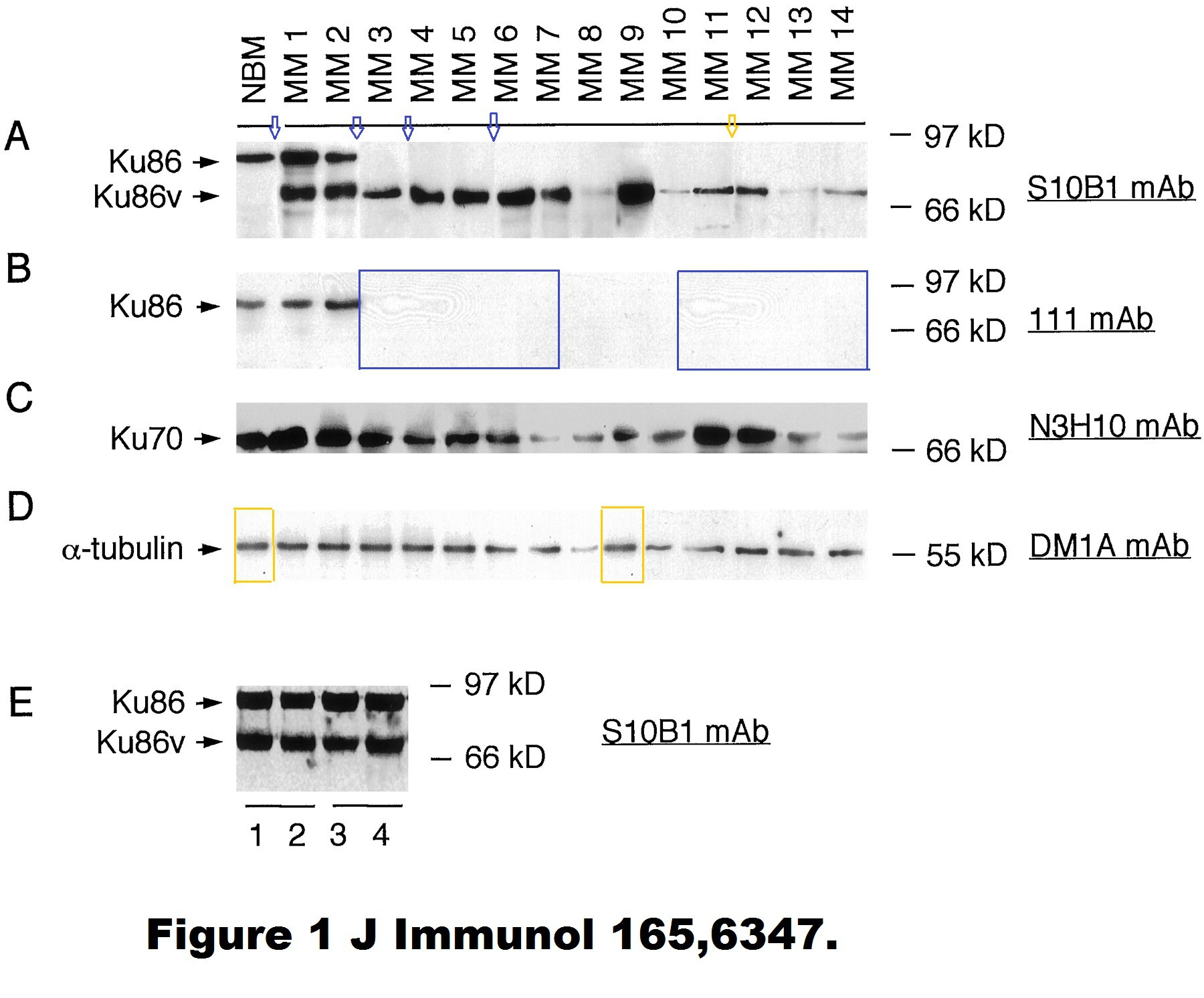
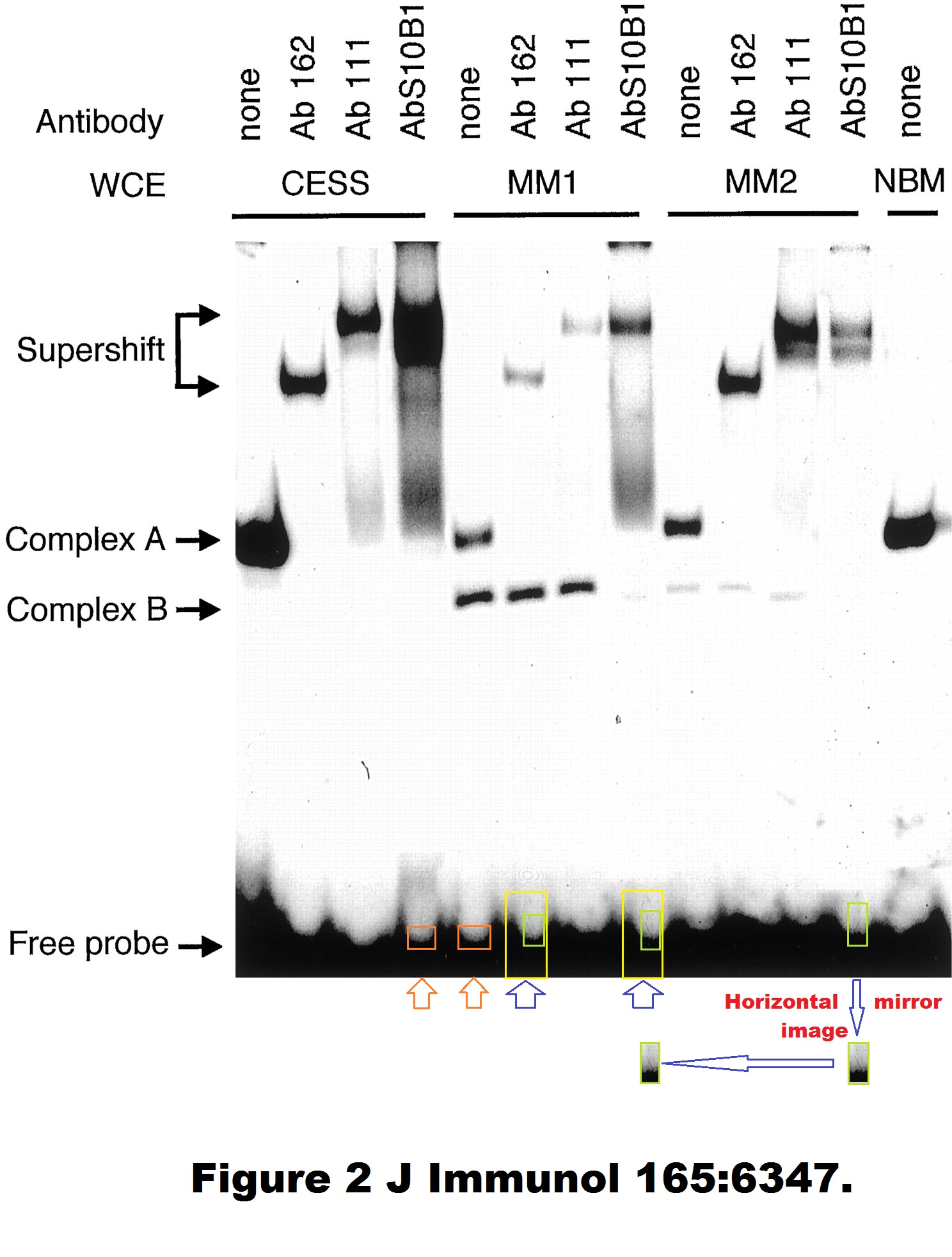
Flagged in 2016, now retracted, on 28 February 2024:
“We wish to retract the article titled “Ku86 Variant […]
There are concerns about the reliability of certain data, arising from errors in the assembly of Figs. 1B, 1D. The authors have concluded that these figures cannot be used to support the conclusions of the article. Given these concerns, the authors would like to respectfully request that this paper be retracted.”
The retraction was signed by all authors except Gerrard Teoh, who was probably not invited on the account of him being publicly exposed as a crook and patient abuser years ago:
“A well-respected haematologist with 26 years of experience was suspended six months and fined $10,000 for using methods “generally not accepted” by the medical profession on a lymphoma patient.
Dr Gerrard Teoh Kheng Hoe, 52, medical director at the Clinic for Blood Disorders and Research at Gleneagles Hospital, was taken to task by the Singapore Medical Council (SMC) after a complaint was lodged on Aug 13, 2009..”
In September 2012, the Singapore Medical Council issued this decision, the charges against Teoh were:
“Dr Teoh recommended and administered to the Patient, Rituximab, Velcade, Dexamethasone, Thalidomide, Zometa therapy (“the VELCADE-based Targeted Therapy”) as a first-line treatment to treat advanced diffuse large B-cell lymphoma (“the Patient’s Medical Condition”), when Dr Teoh knew or ought to have known that it was not a generally accepted method of treatment by the medical profession;
and […] that it was not the appropriate treatment.”
Also, Teoh “provided a picture to the Patient’s family that the treatment
was provided in a trial setting when it was not“; and he was on the payroll
of the “pharmaceutical company that manufactures Velcade“, presumably Takeda.
Teoh was suspended for 6 months and fined $10k. His Singapore clinic continued to operate for over a decade and closed after his retirement in November 2023:

The penultimate author of the retracted DFCI paper is also a haematologist. The Austrian Klaus Podar was another former mentee of Anderson, and Podar has many papers on PubPeer. But he is now a big fish in his home country: Head of Oncology and Haematology at the Karl Landsteiner Private University of Krems, with a second affiliation at the Medical University Vienna. In 2021, Austria recognised one of its greatest cancer researchers:
“For more than 55 years, the province of Lower Austria has been awarding these for outstanding scientific achievements. Researchers are awarded for their theses or scientific projects. The highest award, the Würdigungspreis, recognizes an overall scientific work of supraregional significance. […]
Priv.-Doz. Mag. DDr. Klaus Podar did research for almost ten years at an institute for cancer cure in Boston, where he started his teaching activities in the field of medical oncology.”

Podar and his Austrian university did not reply to my email.
You’ve gotten your pound of flesh already
Retraction for Valerie Weaver, director of the Center for Bioengineering and Tissue Regeneration in the department of surgery and co-director Bay Area Center for Physical Sciences and Oncology at the University of California San Francisco, and an amateur Shakespearian poet.
Pound of Flesh, or Is Cancer Fraud Inevitable?
Ashani Weeraratna and Valerie Weaver, two women in STEM, harassed by trolls.
All lamenting, victimization and tragic poetry didn’t help in this case:
L Damiano , K M Stewart , N Cohet , J K Mouw , J N Lakins , J Debnath, D Reisman , J A Nickerson, A N Imbalzano, V M Weaver Oncogenic targeting of BRM drives malignancy through C/EBPβ-dependent induction of α5 integrin Oncogene (2014) doi: 10.1038/onc.2013.220

In October 2022, Weaver insisted on PubPeer:
“Independent experiments NOT duplicated images“
“it would help if you actually read the paper – these are double stains of the SAME organoids – stained with different antibodies to different proteins – that localize to the same place on the organoid – i would appreciate it if you did not try to tarnish my reputation with these types of accusations – these are legitmate stainings”
In February 2023, Weaver wrote that UCSF opened an investigation and swiftly blamed her first author:
“No intent to deceive was made and if there was an inadvertent error this will immediately be corrected and we will work with oncogene editors The first author and second author refuse to respond to any email or linked in efforts to contact them Ucsf ethics group is currently looking through all data I stand by my trainees and consider them innocent of any misconduct – however if they inadvertently made a mistake when assembling the figures we will fix it“
She also added a long and very poetic rant, excerpts:
“What have you got to hide? What gives you the right to attack others? Your comments suggest I am to simply roll over and accept that your accusations are sound and humbly grovel […]
Many of dr Biks highlighted comments regarding suspicious data in her teams recent posts are completely unfounded and upon examination many of claims of image duplication accusations are not at all true […]
Out of almost 200 articles thus far a few minor errors have been identified
In fact Dr Bik and her attack team – which I gather you are part of – highlighted a duplicate image in an old article that was already identified by my team years ago and an erratum was published – the fact she and her team did not believe me is insane – fortunately the journal sent the reference link where the erratum was published
Shame on you and your colleagues for wasting time and energy attacking innocent mistakes […]
Regardless you’ve gotten your pound of flesh already So enjoy yourself I’m sure you are smugly congratulating yourself“
A year later, instead of her announced Erratum, Weaver published a Retraction.
“The authors have retracted this article, because after publication concerns were raised regarding a number of duplicated images in Figs. 2, 5, 6 and 7. Due to the number of errors, the authors have decided that the article should not remain published in its current form.
The authors are repeating the experiments and will submit a revised version of the article for peer review in due course.
L Damiano, K M Stewart,J K Mouw, J N Lakins, J Debnath, J A Nickerson, A N Imbalzano and V M Weaver agree to this retraction. The publisher has not be able to obtain current email addresses for N Cohet and D Reisman.”
11 and counting
Don’t even try to understand the logic of mass media of what is and what is not newsworthy. Some Nobelist issuing brainfarts about how climate change isn’t real is major news, luckily they also gets debunked, see John Clauser or Ivar Giaever. Another Nobelist retracting ELEVEN papers for data falsification is definitely and absolutely never ever, under no circumstances, newsworthy.
Gregg Semenza: real Nobel Prize and unreal research data
“Even after people have been telling you for, you know, 20 years or more that it’s going to happen, no one expects it.” -Gregg Semenza, Nobel Prize winner 2019
To be fair, Nature wrote about the retractions once, in October 2022. They made sure never to mention my article or Clare Francis (on whose PubPeer work it built), and quoted an anonymous “researcher in the field” who reassured that Semenza’s PubPeer record “does not have the same broad significance” as his Nobel-Prized discovery of the HIF-1 protein.
Anyway, congratulations to 2019 Nobel Laureate for Physiology or Medicine and Johns Hopkins University professor Gregg Semenza on his 11th retraction (here are the other 10). We know from earlier notices there was an institutional investigation against Semenza, but also this remains obviously not newsworthy.
Another crazy thing is that this 12 year old paper was flagged for something NOBODY generally gives a toss about.
Hong Wei , Djahida Bedja , Norimichi Koitabashi , Dongmei Xing , Jasper Chen , Karen Fox-Talbot , Rosanne Rouf , Shaoping Chen , Charles Steenbergen , John W. Harmon , Harry C. Dietz , Kathleen L. Gabrielson , David A. Kass , Gregg L. Semenza Endothelial expression of hypoxia-inducible factor 1 protects the murine heart and aorta from pressure overload by suppression of TGF-β signaling Proceedings of the National Academy of Sciences (2012) doi: 10.1073/pnas.1202081109

“Figure 4F. p-ERK1/2 and t-ERK1/2 panels do not look like they come from the same blot. Figure 4G. p-ERK1/2 and t-ERK1/2 panels look like they come from the same blot.“
In 2012, the paper was “Contributed” to PNAS by Academy member Semenza, bypassing the independent peer review process. On 26 February 2024, a Retraction was published:
“The undersigned authors note, “We are retracting this paper due to the following concerns with presentation of data in immunoblot assays of total and phosphorylated ERK1/2 in Fig. 4F and Fig. 4G. The first issue is that two different blots were used to analyze total and phosphorylated ERK1/2 in Fig. 4F, whereas it appears that the same blot was stripped and reused to analyze total and phosphorylated ERK1/2 in Fig. 4G. The second issue is that there appears to be splicing of lanes in the assay of phosphorylated ERK1/2 in Fig. 4F that was not indicated in the figure. Since the integrity of the data has been questioned and we have not been able to locate the raw data files from over 10 years ago, we request that the paper be retracted. We apologize for any inconvenience this may have caused.”
Charles Steenbergen, Harry C. Dietz, and Gregg L. Semenza”
Consider: yes, this trickery with loading controls is bad practice. But PNAS and other journals normally never even issue corrections for such issues.
Discussed with the highest scientific body
An unexpected retraction for Chitra Mandal, fellow of Indian Academy of Sciences and former director of the CSIR-Indian Institute of Chemical Biology in Kolkata, India. She has a huge PubPeer record of fake science, almost 50 papers. You can read about her fake science in this article by R Prasad, and his reporting in The Hindu, also from June 2019:
““The research has been carried out in different stages of my life in a span of 15 years with the help of hard working, motivated students who are currently in different parts of the world,” Dr. Mandal said in an email to The Hindu .
She added: “I am ready to show all the original data to any reputed scientific body that wants to understand my scientific claim published in the respected journals.”
“Moreover, this matter has already been discussed with the highest scientific body. Such a high-level scientific committee will look at these unintentional human technical errors. I would strongly say that these unintentional minor mistakes do not alter the major scientific outcome and information from these experiments. Subsequently, if suggested by the committee, it will be informed to the respective journals,” Dr. Mandal said.”
Student, Meet Bus
What led to retraction of the Sensei RNA paper by Arati Ramesh in Bangalore: the “factually inaccurate, anonymous, and unverified” version, which “quite frankly, can be termed slander”. And a guest post by “Paul Jones” at the end!
Obviously, she was whitewashed in full by that highest scientific nobody of India. Now here, recent retraction, Mandal’s third (the other two took happened in October 2018 and March 2020):
Ranjita Das , Kaushik Bhattacharya , Sayantani Sarkar , Suman Kumar Samanta , Bikas C. Pal , Chitra Mandal Mahanine synergistically enhances cytotoxicity of 5-fluorouracil through ROS-mediated activation of PTEN and p53/p73 in colon carcinoma APOPTOSIS (2014) doi: 10.1007/s10495-013-0907-6


And the Retraction from 28 February 2024:
“The Editor-in-Chief has retracted this article after concerns were raised about some of the data reported. Specifically:
- The β-actin channel of Fig. 3B appears to be an inverted duplicate of the β-actin channel of Fig. 3A.
- Lanes 1–2 and 4–5 of the nuclear PTEN channel in Fig. 4D appear highly similar to the p53wt PTEN channel in Fig. 4c.
- The β-actin channel of p53null panel in Fig. 6b appears highly similar to the p53wt channel in Fig. 4C.
- The β-actin channel of p53wt panel in Fig. 6b appears highly similar to the p53null panel in Fig. 4C.
The Editor-in-Chief no longer has confidence in the reliability of the article’s findings.
Ranjita Das and Chitra Mandal did not explicitly state whether they agree with this retraction. The remaining authors did not respond to correspondence from the publisher about this retraction.”
Shri Pukka Science of Hindu Nationalism
Together with “Paul Jones” I celebrate here a great Hindu nationalist: Govardhan Das. The immunology professor previously cured tuberculosis with Photoshop, and now he cured COVID-19 with BCG vaccine. All while exposing alleged research fraudsters who dare to criticise the sacred and perfect Modi government!
It should be actually at least 40 retractions. But Mandal is no small sausage in India, and what can you expect from rotten publishers only interested in money. A representative case:
Eswara Murali Satyavarapu , Ranjita Das , Chandan Mandal , Asima Mukhopadhyay , Chitra Mandal Autophagy-independent induction of LC3B through oxidative stress reveals its non-canonical role in anoikis of ovarian cancer cells Cell Death and Disease (2018) doi: 10.1038/s41419-018-0989-8




Mandal is of course also a plagiarist, as Elisabeth Bik found out:
Nilanjan Ghosh, Rituparna Chaki , Subhash C. Mandal Inhibition of Selective Adhesion Molecules in Treatment of Inflammatory Bowel Disease International Reviews of Immunology (2012) doi: 10.3109/08830185.2012.690794



Same in Ghosh et al 2010, in the same Taylor & Francis journal. Bik wrote in July 2023 regarding both papers:
“I reported this article to the journal with concerns over plagiarism in December 2013, but no action was taken.”
A very strong view
Last year, I introduced you in Friday Shorts to Italy’s greatest academic mind of all times – Filippo Berto, 46 year old plonker professor at Sapienza University of Rome, author of over 1200 papers, most of them papermilled, co-authored by Iranian, Chinese and russian fraudsters, and many already on PubPeer.
Berto wrote to me in summer 2023 that he reported his critics “to legal authority and web police“, and otherwise:
“I have dedicated all my life to research with daily dedication sacrifying my private life. I have many international collaborations and I am mentoring several young talented researchers. I have always contributed to the papers that have been published making my real best.“
One was now retracted by Elsevier:
Reza Masoudi Nejad, Zhiliang Liu, Wenchen Ma , Filippo Berto Reliability analysis of fatigue crack growth for rail steel under variable amplitude service loading conditions and wear International Journal of Fatigue (2021) doi: 10.1016/j.ijfatigue.2021.106450

But of course it was not just self-plagiarism, but proper plagiarism, from Huang et al 2013. Moreover, it contained a whole block of nonsense references to paying papermilling fraudsters and Berto’s coauthors from russia, Iran and China -Bokov, Davarpanah, Torghaie, Fakhri etc.
An undated retraction was recently published:
“The article duplicates significant parts of a paper that had already appeared in Engineering Failure Analysis, Volume 128 (2021) 105625 https://doi.org/10.1016/j.engfailanal.2021.105625. One of the conditions of submission of a paper for publication is that authors declare explicitly that the paper has not been previously published and is not under consideration for publication elsewhere. Re-use of any data should be appropriately cited. As such this article represents a misuse of the scientific publishing system. The scientific community takes a very strong view on this matter and apologies are offered to readers of the journal that this was not detected during the submission process.”
Note that Elsevier did not address the papermilling, also Berto’s other copy-cat paper, Nejad et al Eng Fail Anal 2021, remains safe from retraction. Had he not gotten too greedy publishing same fake trash twice, there would be no retraction at all.
I wrote to Berto, he didn’t reply this time. There is no point of writing to Sapienza. This gormless university officially calls him “Renowned Stool of Mechanics of Materials“. OK, not stool, another sitting furniture. But I think stool fits better.
Existence and nature of this company
Alexander Magazinov was triggered by a peculiar papermill retraction in Elsevier:
Jie Zhou , Yao Zhang , Zegui Li , Rui Zhu , Abdol Zeman Stochastic scheduling of a power grid in the presence of EVs, RESs, and risk index with a developed lightning search algorithm Journal of Cleaner Production (2022) doi: 10.1016/j.jclepro.2022.132473
The Retraction notice is undated but recent:
“Post-publication, the editor discovered suspicious changes in authorship between the original submission and the revised version of this paper. In summary, the author names Jie Zhou (new First Author), Yao Zhang, Zegui Li and Rui Zhu were all added to the revised paper without explanation and without the exceptional approval by the journal editor, which is contrary to the journal policy on changes to authorship.
The editor reached out to the authors for an explanation, but they failed to provide a satisfactory explanation to these changes.
In addition, it appears that Abdol Zeman was claiming an affiliation with Sunlife Company, Baku, Azerbaijan. When questioned, the author was unable to provide convincing evidence of the existence and nature of this company.
Overall, the editor feels that the findings of the manuscript cannot be relied upon and that the article needs to be retracted.”
Magazinov made a spreadsheet of 18 papers where this affiliation “Sunlife Company, Baku, Azerbaijan” was used, plus 23 publications declaring as affiliation “Sun-Life Company, Baku, Azerbaijan“, some add “Electrical and Engineering Department” to this fake company’s name. These studies are of course all papermilled. The affiliated authors’ names don’t sound neither Azeri at all, their co-authors are all Chinese.
The Baku company Sunlife not only has an Electrical Engineering Department, it also has a Department of Stomatology:
Lei Lei , Weihong Huang , Ke Liu , Xiaobo Liu , Mingbin Dai , Zhichuan Liu, Yongjian Zhiao Trilazad mesylate-loaded electrospun cellulose acetate nanofibrous wound dressings promote diabetic wound healing by modulation of immune response and protection against oxidative damage Journal of Drug Delivery Science and Technology (2022) doi: 10.1016/j.jddst.2021.102863

Another example, with “EED, Sun-Life Company, Baku, Azerbaijan“:
Ziyuan Li , Tao He , Hashem Farjam Application of an intelligent method for hydrogen-based energy hub in multiple energy markets International Journal of Hydrogen Energy (2023) doi: 10.1016/j.ijhydene.2023.03.124
The above study was published in a papermill-specialised Elsevier outlet “International Journal of Hydrogen Energy” which is run by a Turkish family named Veziroglu. Already in these not even two months of 2024 that journal published around THREE THOUSAND papers, as Nick Wise informed me.
Erdogan’s academic elites
Önder Metin had a rogue PhD student whom he trusted “to ensure their academic growth”. But “mistakes were made by mistake”, conclusions are never affected. Yet those who still complain, will pay dearly.
Magazinov’s spreadsheet also has 47 paper entries for a non-existent “Solar Energy and Power Electronic Co., Ltd, Osaka, Japan” and 15 entries with an affiliation “Arian Company, Yerevan, Armenia“. Again all in Elsevier journals, also here the affiliated Armenian authors have clearly non-Armenian names. Here is one example, the last author claims to work at “Electrical and Engineering Department, Arian Company, Yerevan, Armenia“:
Jiahui Jin , Jiayue Xin , Ahmed Saboor New model to analyze the profit and cost of large commercial by considering solar energy International Journal of Hydrogen Energy (2024) doi: 10.1016/j.ijhydene.2023.08.310
Magazinov sent his spreadsheet to Elsevier, and received this reply:
“Would you please be able to provide more evidence to support the statement that this is a fake private company used as an affiliation?”
Well, this is what Magazinov found to spare Elsevier the arduous task of googling: in the Armenian capital, there is an Arian bakery (last active in 2014), an Arian car dealer, defunct since 2013, an Arian hostel and an Arian jewelry chain. That’s it on Arian businesses.
On behalf of Elsevier, we asked Radio Yerevan if this Arian Company, a global player in green energy technologies, actually exists. The answer: In principle yes, but it only pops into existence during Elsevier’s rigorous peer review.
Science Breakthroughs
The door to new therapies
Amazing news from Portugal! The University of Porto informed on 23 February 2024 (translated):
“Let’s imagine a Big Brother inside a pancreas with tumor cells, a kind of “spy” that allows us to understand everything that happens and, specifically, how this type of cancer develops silently, is so efficient in its proliferation and has such a high mortality rate. It may seem like fiction, but that is precisely what a team from the Institute of Research and Innovation in Health at the University of Porto (i3S) , led by researcher Sónia Melo , did and managed, for the first time, to map the communication of pancreatic cancer . The study has just been published in the prestigious journal Nature Communications and opens the door to new therapies for the disease. […]
This study, highlights the i3S researcher and also a professor at FMUP, “contributes to a better understanding of the biological significance of pancreatic exosomes in health and disease”.
Furthermore, concludes Sónia Melo, “these discoveries have the potential to improve the care provided to patients, since exosomes can be used as therapeutic targets, namely by blocking these communication pathways”.
Zombie scientist Sonia Melo awarded by AstraZeneca
Sonia Melo is back, and not to be messed with. The Portuguese zombie scientist is responsible for a number of papers with manipulated data (only one was retracted, Melo et al, Nature Genetics, 2009), saw her EMBO Young Investigator funding withdrawn in 2016, but was whitewashed and reinstalled by her employing institute Instituto de Investigação e…
This is the study:
Bárbara Adem , Nuno Bastos , Carolina F. Ruivo , Sara Sousa-Alves , Carolina Dias , Patrícia F. Vieira , Inês A. Batista , Bruno Cavadas , Dieter Saur , José C. Machado , Dawen Cai , Sonia A. Melo Exosomes define a local and systemic communication network in healthy pancreas and pancreatic ductal adenocarcinoma Nature Communications (2024) doi: 10.1038/s41467-024-45753-7
“S.A.M. holds patents in the area of EVs biology (miRNA biogenesis in exosomes for diagnosis and therapy, publication number 20200255831; use of exosomes for the treatment of disease, patent number 10959952; Analysis of genomic DNA, RNA and proteins in exosomes for diagnosis and theranosis, publication number 20200200755).”
Cancer cured? Millions to be earned for I3S while curing millions? Not quite.
Sonia Melo, who did PhD in Spain under cheater Manel Esteller and then trained as postdoc at MD Anderson in Texas under the cheater Raghu Kalluri, was previously stripped of her EMBO Young Investigator award and had to retract a paper (Melo et al 2009). The rest of her exosome rubbish on PubPeer was fixed with corrections or just ignored – because I3S and University of Porto declared Melo to be an innocent virgin of research integrity.
Sonia Melo fully exonerated and reinstalled as PI by her Portuguese employer I3S
The Portuguese cancer researcher Sonia Melo has been cleared of all suspicions of scientific misconduct by her employer Instituto de Investigação e Inovação em Saúde (I3S) in Porto. She is now re-installed as research group leader, despite of an earlier EMBO investigation which stripped Melo of her start-up funding and the title of EMBO Young Investigator. Previously, PubPeer users…
So they all in Porto know Melo is a cheater, but this is exactly why they promote her. To inspire the next generation of science cheaters to defraud public money. Melo trained under the very best: Kalluri’s company Codiak Biosciences was founded based on Melo’s fudged research about exosomes, raised many millions in public and private investment, made Kalluri (and his partner Eric Lander) even richer than they were, ran clinical trials, and then went bankrupt in 2023. Because of course that preclinical exosome science was fake, you can sell fraud only up to a point.
But hey, Melo has cured cancer with exosomes once again, her Portuguese university wishes you to know. Because Melo isn’t very smart, she keeps producing same exosome rubbish again and again. Luckily, the editors of Nature Comms are even dumber.
Melo and Kalluri defend discredited Nature paper with preprint, where they admit data “adjustments”
Sonia Melo, the Portuguese cheater scientist and her former US-boss Raghu Kalluri issued some days ago a biorxive preprint, which sole purpose is to defend their discredited Nature paper from 2015. There, they originally claimed to have found a unique biomarker for early pancreatic cancer, a much hailed promise to save lives of many cancer…
The Path of Ideological and Political Education
Frontiers once again is licking the bum of Chinese Communist Party.
A Chinese paper promoting ideological indoctrination already in its title has been “Provisionally accepted” since August 2023, with Frontiers promising that “The final, formatted version of the article will be published soon.” This means Frontiers execs are still checking if the air is clear. Should people whose opinions matter to Frontiers protest too much, the paper will be quietly de-published as if it never happened.
Feng Xue, Silu Liu, Naixue Wei, Xinxiong Wu The Path of Ideological and Political Education in Fulfilling the Function of Psychological Nurturing Front. Psychol. (2023) doi: 10.3389/fpsyg.2023.1202408

I thank all my donors for supporting my journalism. You can be one of them!
Make a one-time donation:
I thank all my donors for supporting my journalism. You can be one of them!
Make a monthly donation:
Choose an amount
Or enter a custom amount
Your contribution is appreciated.
Your contribution is appreciated.
DonateDonate monthly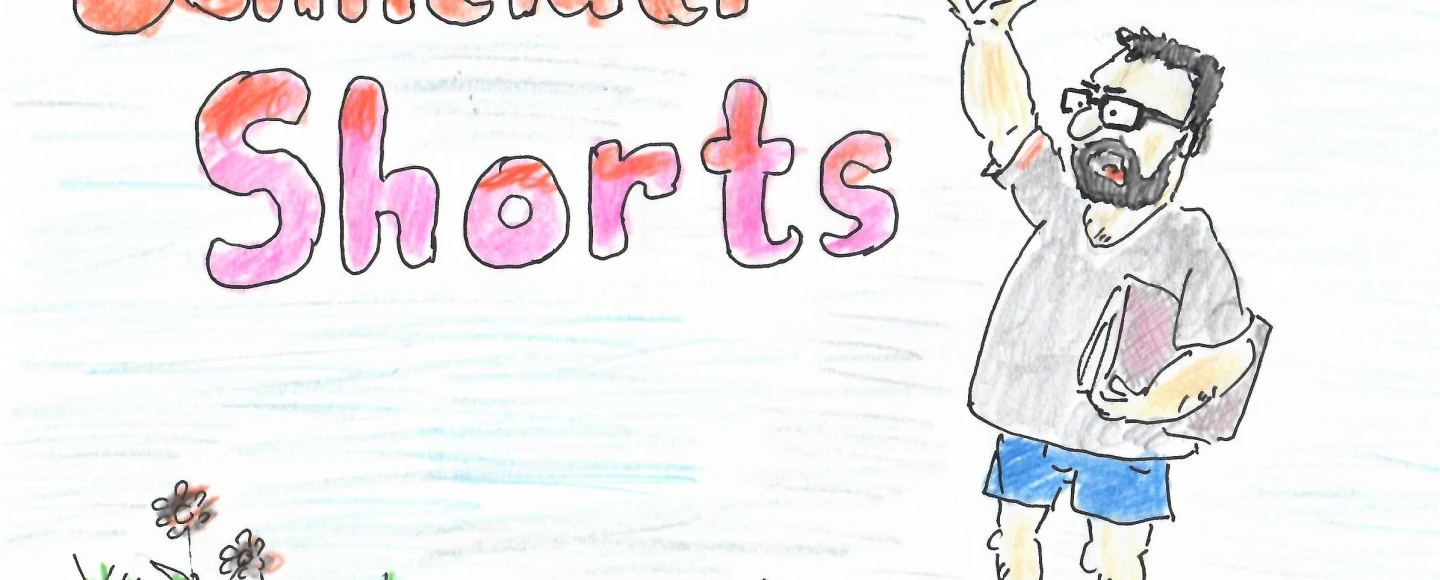


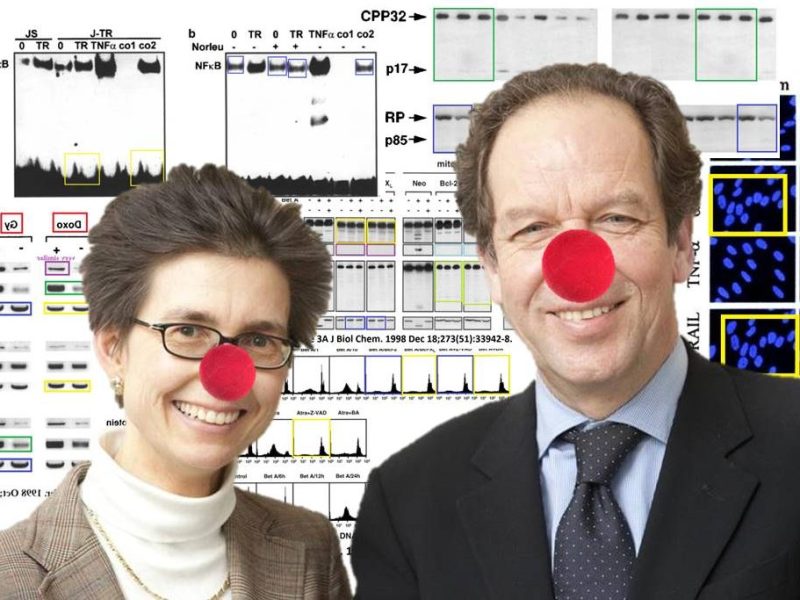
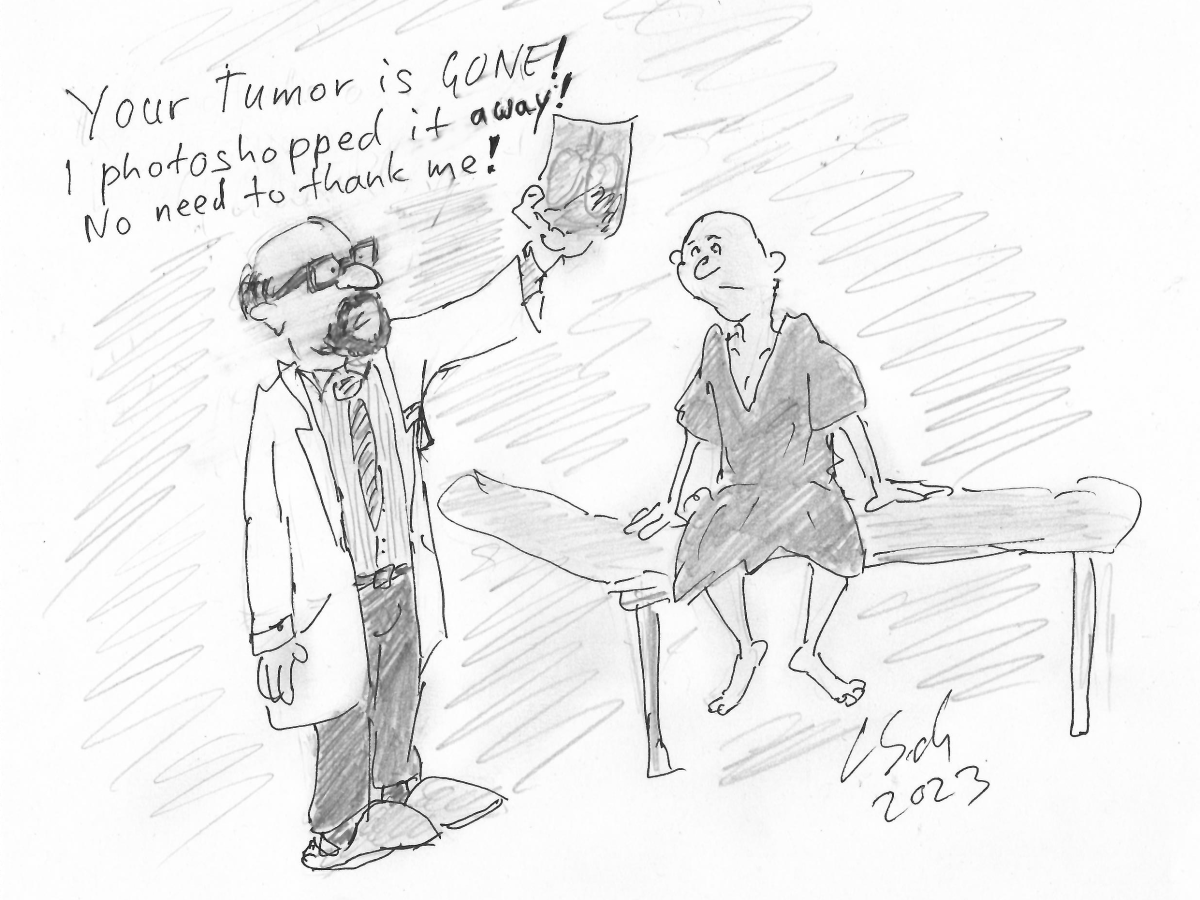


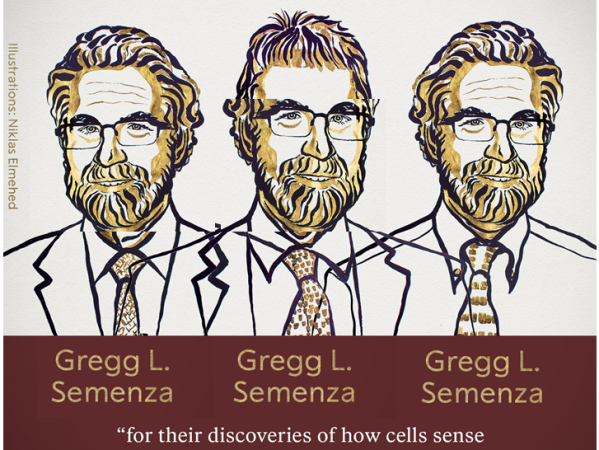
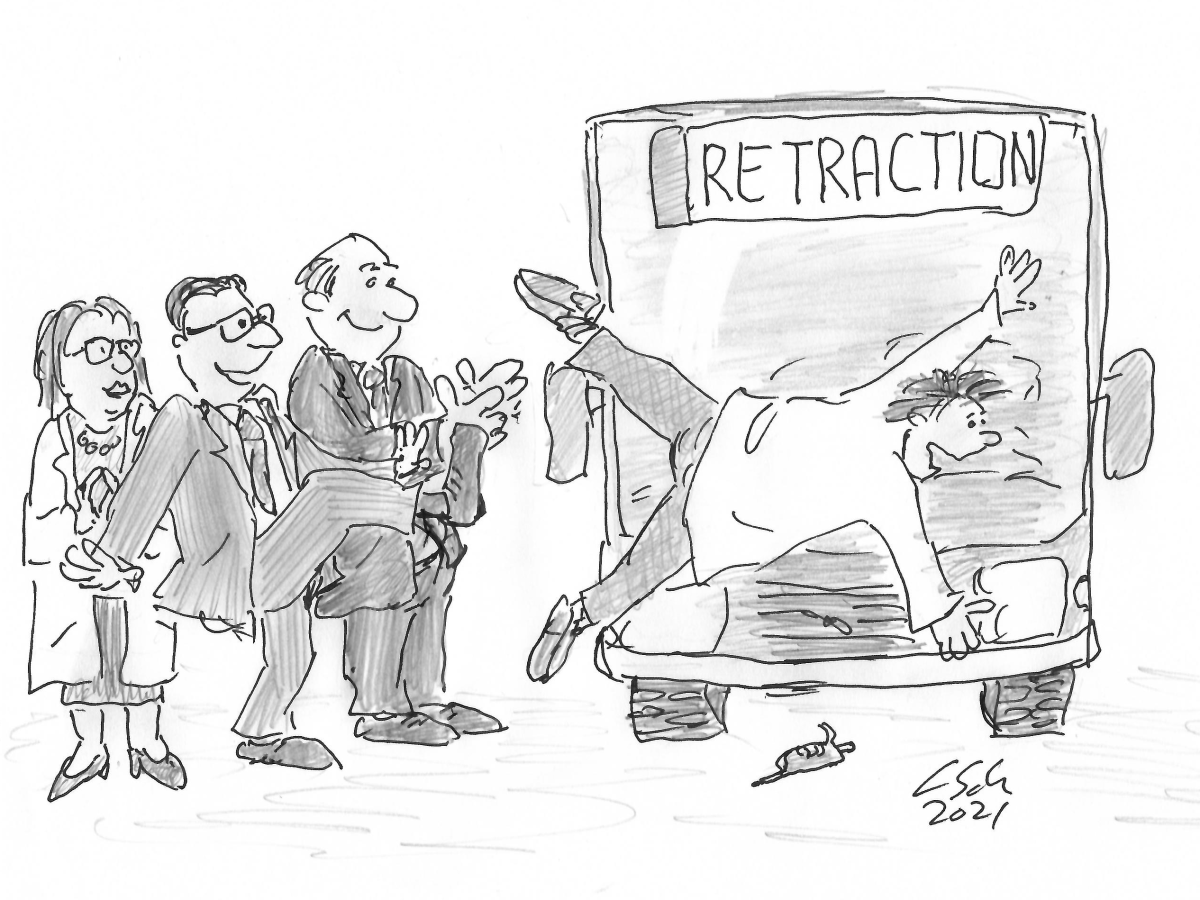





Happy Saint David’s day!
“The first Dana Farber retraction (of the six announced) is there! Congratulations to Ken Anderson!”
If Sholto David, who is on the other side of the Atlantic Ocean, in Wales, can see the problematic data at the Dana Faber Cancer Institute, Harvard, how come the people at Harvard couldn’t see the problematic data years ago?
I wonder what kind of work environment led to the problematic data. Careers of chiselling away, plans to occupy faculty offices? No doubt everything will carry on as usual. The Dana Faber Cancer Institute has instutionalised it. It needs the likes of Kenneth C Anderson, Irene Ghobrial, Laurie Glimcher, and William C Hahn, to farm the grants. In many ways they are quite good value. They know how it is supposed to look, know the gossip about how cancer is supposed to happen, can talk the talk even. They did predict how it was imagined to be.
Even if there were 60 retractions the foundations of the Dana Faber Cancer Institute will remain solid. Nobody will be reassigned, or demoted.
LikeLike
Kenneth C Anderson’s 4th retraction.
Retraction Watch Database (retractiondatabase.org)
LikeLike
Faith E Davies, who is on the Kenneth C Anderson retraction
Faith E. Davies, MD | NYU Langone Health
has this problematic publication
PubPeer – Heat shock protein inhibition is associated with activation…
The authors dismiss the scientific criticism by mentioning how many have cited the paper. I never thought that ever changes the data.
LikeLike
With Paul Workman.

These people always find each other.
LikeLike
“The Austrian Klaus Podar was another former mentee of Anderson…”
More golden nuggets:-
PubPeer – Mcl-1 confers protection of Her2-positive breast cancer cell…
PubPeer – Combination of proteasome inhibitors bortezomib and NPI-0052…
LikeLike
Kenneth C Anderson. More pearls of wisdom:-
PubPeer – Combination of proteasome inhibitors bortezomib and NPI-0052…
PubPeer – A 13 mer LNA-i-miR-221 Inhibitor Restores Drug Sensitivity i…
LikeLike
Dana Faber Cancer Institute again. Perhaps I am missing something.
PubPeer – Complete response to donor lymphocyte infusion in multiple m…
LikeLike
A miracle! Dana Faber Cancer Institute bilocation.
https://pubpeer.com/publications/CCA995FA092D911D41C7C83F6AFB5E#1
It’s how much you believe that matters.
LikeLike
“An old associate of Poulaki, they trained together with Adamis – Antonia Joussen, head of ophthalmology at Charité Berlin and the REAL victim of harassment, bullying and abuse.”
Anthony P Adamis appears to have problematic data going back a long way.
https://pubpeer.com/search?q=Adamis+
LikeLike
A second Dana Faber Cancer Institute miracle so soon after the first. What more proof can you wish for? Only doubting Thomasses will fail to believe!
https://pubpeer.com/publications/5486BC6746385F7B49129408B6D375#4
Srcoll up! Scroll up!
LikeLike
“blessed are they that have not seen, and yet have believed.”
LikeLike
The first author of the second miracle is currently a professor at the Dana Faber Cancer Institute, Harvard,
https://www.dana-farber.org/find-a-doctor/constantine-s-mitsiades
the second author of the second miracle is currently at UC Davis, California,
https://health.ucdavis.edu/news/headlines/cancer-center-appoints-new-chief-translational-officer-/2022/09
which goes to show the power and reach of the Dana Faber Cancer Institute, Harvard.
Veritas!
LikeLike
The suit and tie, in this case a bow tie, lends veracity.
https://eye.hms.harvard.edu/demetriosvavvas
https://pubpeer.com/publications/F36DB87292F34D535E4BE264779F2E
He is still arguing the toss about the problematic data. He must be blind, and he is a big ophthalmologist at Harvard!
VERITAS!
LikeLike
“Okay, Harvard … we’ve had a problem here.”
LikeLike
All those pairs of eyes, but it is Harvard after all, what did you expect?
https://pubpeer.com/publications/E38C4E58FEFAF42DE88434A54BD85E#1
LikeLike
Constantine Mitsiades (second author), a Vasiliki Poulaki was the first author, and Nicholas Mitsiades (senior author) already had an Expression of Concern issued against them in 2015.
PubPeer – Constitutive nuclear factor-kappaB activity is crucial for h…
That should have been enough for Harvard to check all their papers then. 9 years wasted.
What a lost opportunity!
LikeLike
“Significant overlap” between figures spurs note of concern for 13-year-old retinoblastoma paper – Retraction Watch
Harvard used kid gloves, looked the other way.
LikeLike
Vassiliki Poulaki, Nicholas Mitsiades, Constantine Mitsiades, Anthony P Adamis, and uncle Tom Cobley and all. Another Greek tragedy.
PubPeer – Insulin-like growth factor-I plays a pathogenetic role in di…
LikeLike
An old associate of Poulaki, they trained together with Adamis – Antonia Joussen, head of ophthalmology at Charité Berlin and the REAL victim of harassment, bullying and abuse.
LikeLike
Another act in another Greek tragedy. Vassiliki Poulaki, George D. Yancopoulos, Anthony P. Adamis.
PubPeer – Acute intensive insulin therapy exacerbates diabetic blood-r…
Scroll up!
LikeLike
George D. Yancopoulos is this guy
George Yancopoulos – Wikipedia
LikeLike
Vassiliki Poulaki, Nicholas Mitsiades, Constantine Mitsiades, and Anthony P. Adamis. Reminds me of ideas of how to communicate with extraterrestrial lifeforms Ideas of repeated geometry.
https://pubpeer.com/publications/031E1F832B8FDB05E812E4910272CA#6
LikeLike
A little bit more from professor Demetrios Vavvas G Vavvas, Harvard.
PubPeer – Mitochondrial DNA has a pro-inflammatory role in AMD
LikeLike
Hi Leonid, the DOI of https://www.frontiersin.org/journals/psychology/articles/10.3389/fpsyg.2023.1202408/abstract does not exist / is inactive / does not resolve.
LikeLike
It is working for me now (at 5:23 PM EST in Boston MA USA).
LikeLike
The abstract to the Melo paper is near-gibberish: ”Pancreatic ductal adenocarcinoma (PDAC), a lethal disease, requires a grasp of its biology for effective therapies. Exosomes, implicated in cancer, are poorly understood in living systems. Here we use the genetically engineered mouse model (ExoBow) to map the spatiotemporal distribution of exosomes from healthy and PDAC pancreas in vivo to determine their biological significance. We show that, within the PDAC microenvironment, cancer cells establish preferential communication routes through exosomes with cancer associated fibroblasts and endothelial cells. The latter being a conserved event in the healthy pancreas. Inhibiting exosomes secretion in both scenarios enhances angiogenesis, underscoring their contribution to vascularization and to cancer. Inter-organ communication is significantly increased in PDAC with specific organs as most frequent targets of exosomes communication occurring in health with the thymus, bone-marrow, brain, and intestines, and in PDAC with the kidneys, lungs and thymus. In sum, we find that exosomes mediate an organized intra- and inter- pancreas communication network with modulatory effects in vivo.”
Does “inter-pancreas communication” mean that both of them in your body can talk to each other? Or is that kidneys?
LikeLike
Aah, don’t be so nit-picking, they exchange emails only through the network. 🙂
LikeLike
Yeah, guess I’m a bit touchy. My dad died from pancreatic cancer. If only a genius like Melo had been on the case, with her highly efficient and effective use of competitive funding. Who knew it was all about mouse organs talking to each other. Or even between mice. What a brave new world…..
LikeLike
And it keeps getting both braver and newer. Despite being inappropriate sometimes, sarcasm is a good cure against despair.
LikeLike
I am really disappointed Melo is not a member here.
https://www.i3s.up.pt/ethics-integrity
LikeLike
If she becomes one, you will be responsible for that. And probably less disappointed…
LikeLike
Also, I find the term of “communication” to be abusely employed in this abstract and, more generally speaking, in biology. .
LikeLike
From: https://twitter.com/Sonia_A_Melo/status/1760254719589503147
“Dive deeper into our paper by exploring the “Behind the Paper” section for a summary and an open forum to discuss our findings” Maybe someone needs to pay a visit to this melotoast forum. Oops. I meant milquetoast forum.
LikeLike
The guy behind Sunlife Company founded the biggest papermill of Iran: http://www.sciencepeak.com/ . since May 2023 this papemill become fully functional and stands dominant in the market. Worth an investigation.
LikeLike
“Discussed with the highest scientific body – Chitra Mandal retracts paper, just when everyone gave up”
Naive 19 February 2024 correction in Int J cancer.
19 February 2024 correction. https://onlinelibrary.wiley.com/doi/10.1002/ijc.34888
Concerns were raised by a third party regarding the appearance of Figure 2c, suggesting that the Neu3 and β-actin bands were cropped and juxtaposed giving the impression that they were run next to each other on the same gel. The authors admitted to the cropping of the bands from the same gel and although they were not able to find the original image from which the bands of Figure 2c were cropped, they have provided an experimental replicate of the gel in which the bands are separated by a marker ladder. The authors confirm that all the experimental results and corresponding conclusions mentioned in the paper remain unaffected and sincerely apologize for this error. The corrected Figure 2c as well as the image of the experimental replicate gel is shown as follows.
The correction does not mention figure 6a.
PubPeer – Down regulation of membrane-bound Neu3 constitutes a new pot…
LikeLike